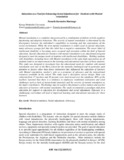Education as a Tool for Enhancing Social Adjustment for Students with Mental retardation
Abstract
Mental retardation is a condition characterized by a combination of deficits in both cognitive
functioning and adaptive behaviour. The severity of mental retardation is determined by the
discrepancy between the individual’s capabilities in learning and the expectations of the
social environment .While the term mental retardation is widely used in special education,
many advocacy groups feel that this label has a negative connotation. The newer label of
intellectual disability is becoming more accepted and prevalent within the field of Special
education. Special education for learners with mental retardation is an educational program
designed to meet the unique needs of students with intellectual disabilities. Holding students
with disabilities, including those with Mental retardation to the same high expectations as all
students leads to an improvement in the learning and educational outcomes of these students.
This study was designed to investigate how the educational needs for students with mental
retardation were met at the Meru school for the mentally challenged and in particular paid
attention to factors other than direct instruction that influenced the education of learners
with Mental retardation, teacher’s role as a promoter of advocacy and the instructional
resources available in the school. The study used a descriptive survey design. Data was
collected from 17 teachers and 20 parents were interviewed over the telephone. 80% of the
teachers reported that there is a tendency to emphasize traditional instruction and cited
challenges such as lack of instructional materials and the severity of mental retardation as
the major contributors. The findings may be useful to the planners, policy makers and teacher
educators of learners with mental retardation. The study recommends a paradigm shift from
education for support to education for development and social adjustment. Exposure to a
challenging curriculum will lead to improved learning and educational outcomes for these
learners.

